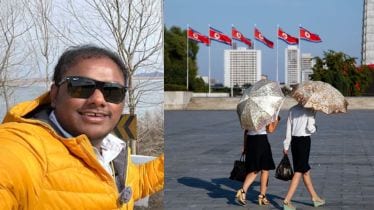Travel influencer Bhuvani Dharan, known online as @tamiltrekker, was given a bunch of instructions before stepping into one of the world’s most tightly controlled regimes, the Democratic People’s Republic of Korea (DPRK), more commonly known as North Korea.
Dharan was part of a 22-member group of tourists and influencers who entered the reclusive country for four days, marking the first and only batch of foreigners allowed in after a five-year border shutdown triggered by the Covid-19 pandemic. A few days later, the country shut its doors again, making Dharan not just one of the first but also one of the last to step inside.
“Don’t go anywhere alone.” “Don’t film anyone working too hard.” “Always address Kim Jong Un with ‘Captain’ or ‘Marshall’.” These were among the strict instructions that the group received before their entry into the country.
An Indian travel influencer’s experience in North Korea
To reach Rason, the northeastern city where the group would stay, the journey began in China. Tourists had to obtain multi-entry Chinese visas in advance. After arriving in Yanji, China, the group underwent a two-hour security clearance before being transported across the border into North Korea.
From the moment they entered, the visitors were under constant supervision. Military personnel conducted detailed checks of both their luggage and personal electronics. “We had to list every item, especially electronics. They wanted to be sure we weren’t bringing in GPS devices, religious texts, or adult content,” Dharan recalled.
He also became one of the rare travellers to receive an official passport stamp from North Korea, which typically avoids such documentation.
Public places barely had any ‘public’
The first stop upon entering the country wasn’t the hotel, but a mineral water plant. Dharan described the visit as “oddly quiet” and “staged,” noting the facility appeared operational but had only two workers that they could see.
For the next four days, the group followed a non-negotiable itinerary confined entirely to Rason. Dharan noted that despite being shown different sites, they often took longer routes, likely to give the illusion of broader travel. “We were just circling within a small radius,” he said.
The group’s visits included schools, factories, museums, and even courtrooms. However, the influencer said many of the interactions felt pre-planned. At a school, he met a student who said he could speak English and Russian. “Since I’ve been to Russia, I tried speaking in Russian, but the child froze. It felt like his responses were rehearsed,” Dharan shared.
Another red flag came during a stop at a school basketball court. Children were seen playing when the group arrived, but as soon as they left, the court was empty. “It was like someone called ‘cut’ on a film set,” he said.
Cultural performances by students were also on their itinerary, but none of the students seemed cheerful. “Even though the kids performed well, their faces looked blank. There was no joy in their expressions,” Dharan noted.
Marshall’s Monument
One of the most tightly choreographed moments came on Day 2, when the group was taken to pay respects at a statue of Kim Jong Un. Before arriving, they were instructed on proper protocol – buy a plastic flower, place it at the statue’s base, and bow deeply.
“We were told that if we couldn’t show proper respect to the Marshall, we should stay back in the bus,” Dharan said.
According to Dharan, the entire city felt “like a performance.” He saw taxis operating at 5 am and families dressed in traditional clothing posing for photos, yet none of the locals ever initiated a conversation. At night, the city became eerily quiet. “From my hotel room window, I couldn’t spot a single person after sunset. But by 5 am, people would magically reappear, sweeping courtyards and watering plants,” he said.
When locals were asked about India, their unanimous response was, “Baahubali.” “It felt like a rehearsed line, possibly meant to signal that they’re aware of international cinema,” Dharan added.
Food and drinks in North Korea
The hotel stay was comfortable, with clean rooms and cold, curated meals. Western dishes made up most of the menu. “Local cuisine was only served to our guides and drivers. Ours seemed pre-prepared and reheated,” Dharan observed.
However, one thing stood out for him – alcohol. The group visited breweries and distilleries, including one that made liquor from exotic and alarming ingredients like tiger bones, bear bones, and even snakes. “I didn’t dare drink it there. But back in China, I took one sip and immediately threw it out. I didn’t want to risk my life,” he joked.
Check out the video here:
How much money he spent in North Korea
Dharan spent an estimated Rs 4–5 lakh on the trip, including Rs 1–1.5 lakh on the base tour and the rest on local purchases. He sent four postcards to friends and family, each costing around $100. None have reached their destination. “I even sent one to myself. Still waiting,” he said.
He also deposited money for a local ATM card, but never received one. “There were no working ATMs anyway,” he added.
How the exit went
During a brief visit to the border between North Korea, China, and Russia, the group caught fleeting access to a mobile signal. That’s when Dharan saw a news alert that said, North Korea had officially shut its borders again.
“I was panicked. I thought we might be stuck,” he admitted. Eventually, they were reassured that their departure was still on schedule.
When asked by NDTV whether he’d return if given a chance, Dharan responded with a half-smile: “They told us very clearly, if we say anything negative in our posts, we won’t be allowed back in. So no, I don’t think I’ll ever return. I won’t be allowed.”
